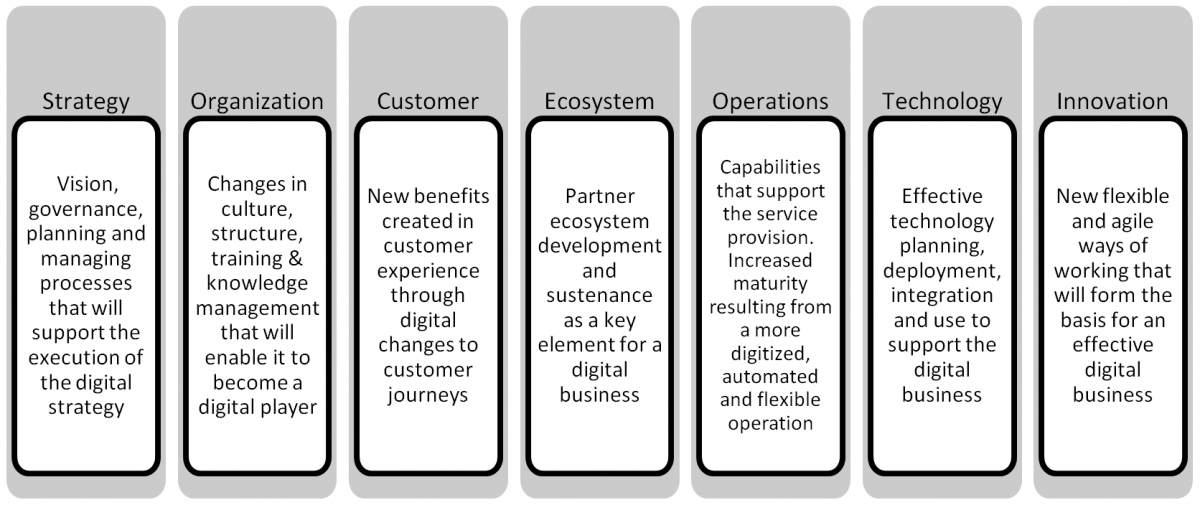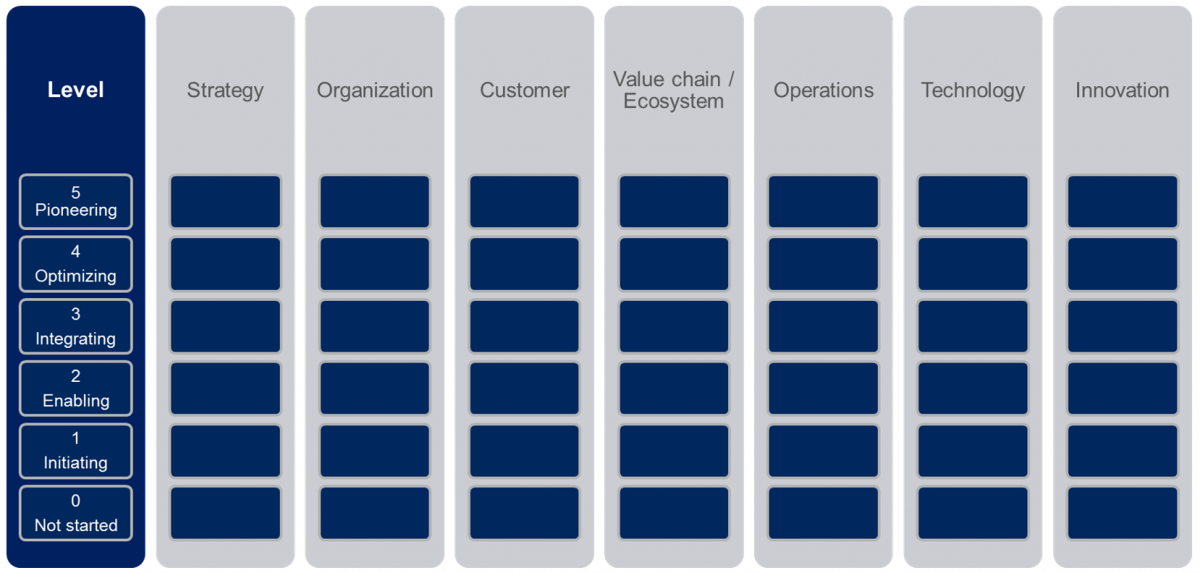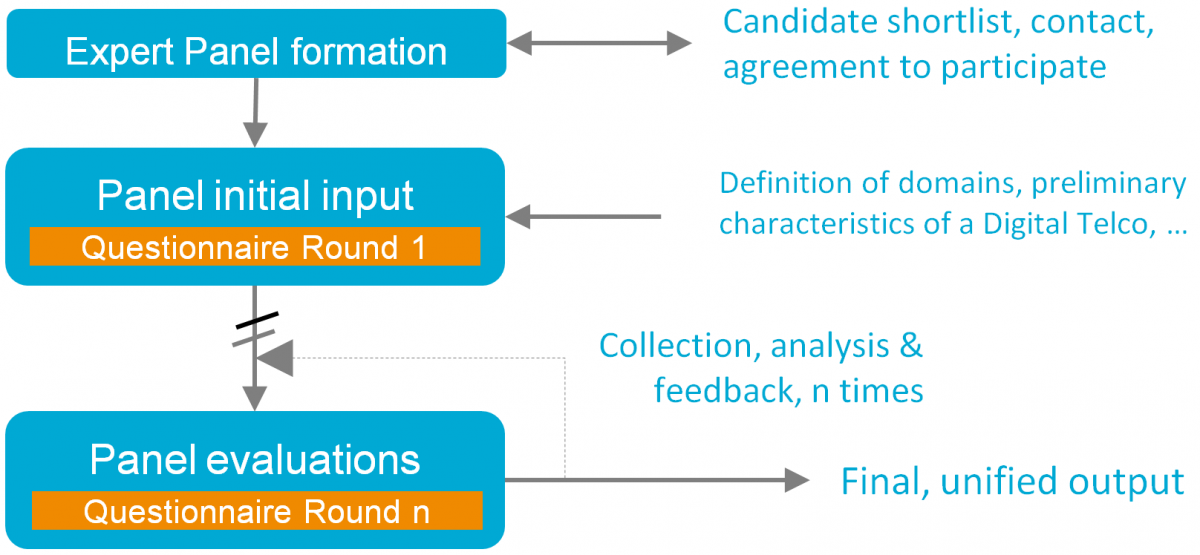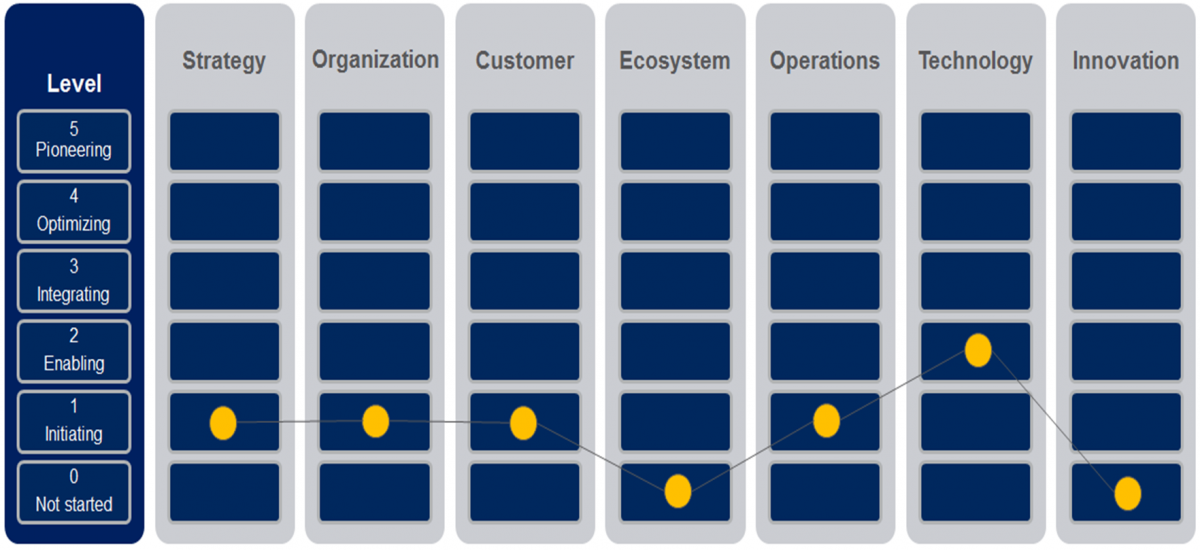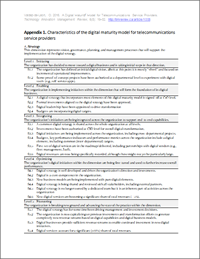AbstractAn organization’s capabilities become its disabilities when disruptive innovation is afoot.
Clayton Christensen
Professor, business consultant, and author
In The Innovator’s Dilemma
Industries across the spectrum are being faced with a fundamental change: digital transformation. The telecommunications industry is no exception. For communications service providers, this transformation started some time ago with the emergence of so-called over-the-top (OTT) services such as WhatsApp and Skype. However, in spite of such transformation being underway, there is a lack of frameworks and tools to help communications service providers navigate such radical change. This article presents the findings of a research project to develop such a framework: the digital maturity model for telecommunications service providers. The model aims to offer a structured view of digital transformation that is specific to the context and challenges of the telecommunications industry and that can be used as a standard to help communications service providers benchmark themselves against peers or themselves as they advance their transformation. This article describes the need for the model and the methodology used to develop it, and it offers recommendations on how to use the model and further develop it as our understanding of digital transformation evolves.
Introduction
Communications service providers are being faced with a deep transformation that is taking them from being providers of traditional communication services (e.g., voice, SMS) into providers of digital services (e.g., music, mobile TV, cloud services, Internet of Things) This digital transformation – the use of technology such as analytics, mobility, social media, and smart embedded devices to improve the performance or reach of an enterprise (Westerman et al., 2011) – also requires communications service providers to digitize the way they serve their customers throughout the entire customer lifecycle. Thus, the transformation is disruptive; it affects not only customer relationships, but internal processes and value propositions as well (Westerman et al., 2011).
A number of factors are identified as key drivers for digital transformation, including:
- Technological advancement: everything is being connected to the Internet or is being digitized. Examples of this include connected vehicles and the digitization of money.
- New breeds of firms providing digital services that utilize the infrastructure of communications service providers (e.g., mobile networks) yet appropriate most of the value generated. Examples include firms such as Spotify and WhatsApp.
- A change in customer expectations, which are being molded towards an always-connected, personalized lifestyle and digitized services.
- The commoditization of traditional communication services and consequent revenue flat-lining or outright decline (see Kendall, 2014).
Two examples help illustrate this transition: AT&T in the United States and Rogers in Canada. In 2013, AT&T launched a completely new service for home security monitoring, which has since become a case study on how to successfully move into digital services. In 2014, Rogers launched a program with the aim of transforming the customer experience by digitizing the entire customer lifecycle. Rogers has reportedly managed to drastically transform customer experience as shown by a significant increase in the number of customer interactions happening through digital channels, drastic improvements in customer satisfaction metrics, and reductions in customer complaints (Deloitte, 2016). However, these two examples appear to be exceptions rather than the rule, and most communications service providers are still struggling to figure out their transformation journey.
Such transformations go deep into every aspect of the businesses and operating models of communications service providers, yet there is a lack of tools and guidelines to help operators negotiate such change. Indeed, several researchers (e.g., Friedrich et al., 2015; Kuebel et al., 2014; Ovum, 2014) have shown that communications service providers are already committed and are taking steps towards digital transformation, but lack a clear path or guide. They all are taking divergent routes, in many cases changing course as they “try and learn” (Friedrich et al., 2015).
To navigate their digital transformation journey in a more confident and structured manner, these organizations look to existing frameworks, including seminal works in IT-enabled business transformation (e.g., Venkatraman, 1994) as well as more recent developments in digital transformation practice (e.g., Gerbert et al., 2015; McKinsey, 2015; Westerman et al., 2012). These frameworks offer a good structure and understanding of the digital challenge; however, they also tend to be too general and high-level in their coverage. The reason for this is likely to be that all have been designed to be generic in nature to apply to any industry. None of these models are specific to the telecommunications industry and as such are not designed to offer specific guidance to build a telecommunications-specific pathway to digital transformation.
A model that fills that gap is needed. Such a model should:
- Offer a structured view of digital transformation.
- Be comprehensive enough to cover all aspects of digital transformation.
- Be specific to the context and challenges that communications service providers are facing.
- Not only describe the current situation but also offer a view of what a more advanced, digital communications service provision looks like.
- Be able to be used as an industry standard to help communications service providers benchmark themselves against peers or themselves as they advance their transformation.
The model presented here – the digital maturity model for telecommunications service providers – is intended to fill this gap. This article will first describe the methodology used to design and develop the model. Next, it will introduce the model, including its constituent dimensions and levels of maturity. Finally, the article will explain how it can be used in practice and further developed.
Methodology
In developing the model, a three-stage approach was followed, based on the best-known practice in the development of these type of models (Becker & Knackstedt, 2009; De Bruin et al., 2005):
- A clear definition of the scope of the model.
- An initial design or architecture of the model.
- An iterative approach to validate (with experts in the field) the design of the model.
Defining the scope
From the outset, the focus of the model was very clear: the digital transformation of communications service providers. More specifically, the scope of the digital maturity model is to help communications service providers to identify their current position in a digital maturity scale and be able to define a vision and a plan for moving up that maturity spectrum.
Designing the initial model
The design stage began with a comprehensive review of the relevant literature, case studies from several industries, and interviews with subject matter experts. These activities formed the basis for the identification of a set of key elements of digital transformation, which in turn resulted in a multi-dimensional model. The seven dimensions that comprise the model are depicted in Figure 1.
Figure 1. The initial structure and seven dimensions of the digital maturity model for telecommunications service providers
A progressive, multi-staged approach to transformation was then integrated into the model. The objective was to go beyond a plain low–medium–high notion and create a maturity scale that was more nuanced (reflecting the actual challenge) and industry-specific – one that had high granularity without becoming too complex. Five levels of maturity were selected and integrated into the model skeleton, or outline, which included the seven dimensions (see Figure 2).
Figure 2. Initial outline of the digital maturity model for telecommunications service providers
Detailing and validating the model
Next, an initial set of characteristics for each element in the matrix was defined. This step included a review of existing literature, examination of other available models, and input from experienced practitioners in the subject matter. Once a first draft of the model was completed, the final step was to take this draft to an external group of experts for them to scrutinize, criticize, and help further develop into a fully-fledged maturity model.
The Delphi method was used to complete the development of the model because of its distinct suitability in capturing expert input for new concept or framework development in areas where there is limited empirical evidence (Okoli & Pawlowski, 2004), as it is the case of digital transformation in the telecommunications industry. The method involves the recruitment of a panel of experts in the subject matter and the iterative polling of the panel via structured questionnaires. A number of polling rounds is performed until a consensus is reached (Figure 3). For this study, a panel of 10 experts was formed, including a mix of authorities that came from communications service providers, academia, and the industry analyst and consultant communities.
Figure 3. The Dephi method
The Model
The outcomes of the Delphi study included:
- The definition of an overall maturity model with clearly defined dimensions and levels of maturity (see Figure 4 and Appendix 1).
- The establishment of a set of characteristics that digital communications service providers are expected to demonstrate at defined levels of maturity for each of the dimensions that comprise the model.
Dimensions
The seven dimensions of the final model (refined and reordered through the model development process) are as follows:
- Strategy: Representing the vision, governance, planning, and management processes that will support the implementation of the digital strategy.
- Organization: Characterizing the changes in communications, culture, structure, training, and knowledge management within the organization that will enable it to become a digital player.
- Customer: Focusing on customer participation and empowerment, as well as new benefits created in customer experience through digital transformation of customer journeys.
- Technology: Representing the capabilities that enable effective technology planning, deployment, and integration to support the digital business.
- Operations: Focusing on the capabilities that support the service provision. Increased maturity within this dimension demonstrates a more digitized, automated, and flexible operation.
- Ecosystem: Signifying partner ecosystem development and sustenance as a key element for a digital business.
- Innovation: Focusing on the capabilities that enable more flexible and agile ways of working that will form the basis for an effective digital business.
Figure 4. The completed digital maturity model for telecommunications service providers showing a hypothetical organization's maturity levels for each of the seven dimensions
The dimensions aim to cover the vital areas of the business that are impacted and in turn impact digital transformation. As discussed above, the dimensions were the result of extensive research and insight from practitioners in the subject. Remarkably, throughout the study, two dimensions came up frequently as critical but were frequently underestimated in their importance in digital transformation: Ecosystem and Innovation. The importance of these two areas is ostensibly owing to the dynamic nature of digital technologies and the importance of continuous innovation, going beyond the boundaries of one single firm. For this reason, the two dimensions are distinguished from one another in the model.
Maturity levels
Maturity in each dimension is assessed across five levels (plus a default level zero reflecting a state of inaction). In order of decreasing maturity, these levels include:
5. Pioneering: The organization is breaking new ground and advancing the state of the practice within the dimension.
4. Optimizing: The organization's digital initiatives within the dimension are being fine-tuned and used to further increase overall performance.
3. Integrating: The organization's initiatives are being integrated across the organization to support end-to-end capabilities.
2. Enabling: The organization is implementing initiatives within the dimension that will form the foundation of its digital business.
1. Initiating: The organization has decided to move toward a digital business and is taking initial steps in that direction.
0. Not started: The organization has not taken any steps to transform.
The levels represent the progression stages of a communications service provider in its digital transformation journey. Each level includes a set of characteristics (see full details in Appendix 1) that a business must demonstrate in terms of implementations, investments, or established capabilities in order to be situated at that particular level. Each level builds on the previous one. As the organization implements and integrates the various changes that are pertinent to its digitization journey, the maturity rating would rise across the applicable dimensions.
Use of the model
The model aims to depict the level of maturity of a communications service provider at a given point in time. It also provides a vision of what a more mature digital business looks like. However, the model is not prescriptive as to what is the "best way" to move up in the maturity scale. It also does not suggest that Level 5 is a requirement for all organizations. Instead, it is an implementation model where the levels are a snapshot of the extent of implementation.
It is indeed of vital importance for each organization to define the level of maturity it wants to attain, in line with its business ambitions, context, resources, and timeline. The model can be used to define the current level of maturity, and as a guide through the transformation journey in the desired timeframe. The model can also be used as a benchmarking tool to evaluate an organization's own position against a competitor or a peer, or between operating companies within the same group. Finally, the model can be used to evaluate progress and to assess results of previous investments. In summary, examples of how the model can be used are as follows:
- to provide a structured view of current and target positions (e.g., where do we want to be in five years?)
- as a benchmarking tool
- to identify deficiencies in an area that may adversely affect the overall effectiveness of transformation efforts
- as a support tool to define next steps and priorities in digital transformation
- to assess whether the organization has properly prioritized and ordered implementation efforts, or whether it has "the cart before the horse"
- to assess or confirm results from previous investments
Conclusion
The digital maturity model described in this article was developed to help telecommunications service providers in their digital transformation journey. The motivation for developing such model originated from the clear absence of industry-specific tools available to guide such transformations. The resulting model is intended as a tool to gauge digital maturity at a particular point in time and to help develop a vision and a roadmap for digital transformation. It is recommended that practitioners adopt the model as a central component of a toolbox for digital transformation.
The model is intended as a tool to define current and target states of maturity; however, it is not prescriptive as to suggest a best way to achieve the target state. As such, it is suggested that complementary tools should be developed to help define the "best practices" and further develop the framework. For example, such best practices can be developed based on in-depth empirical evidence as more communications service providers embark on journeys of digital transformations, and as successes and failures become better understood and documented.
Finally, although the model was designed for telecommunications services providers, the framework may be of interest to other industries, especially those in services. Therefore, industry-specific adaptations are advised to make the model fit for the particular industry.
Acknowledgments
This research project was supported by Ericsson, where the author works as a Senior Consultant within the Global Consulting and Systems Integration practice. The author would like to thank and acknowledge the contributions of a number of people that agreed to take part in an expert panel. In alphabetical order, the panel members include:
- Alejandro Maroto, Global Head of Innovation & Business Development, Telefonica
- Giorgio Santini, Director EMEA, Gartner
- Dr. Mark H Mortensen, Research Director, Digital Economy Platforms Research, Analysis Mason
- Dr. Mischa Dohler, Professor & Head of the Centre for Telecommunications Research, King’s College London
- Richard George, Director of Digital, Eir
- Simone Bruschi, Head of Digital Banking - Retail, Banca Monte dei Paschi di Siena
- Simon Torrance, CEO of Metaflight, Senior Advisor at Analysis Mason and founder of Telco 2.0
- Thao Tu, Head of Business Consulting at Ericsson
Thank you also to those that decided to remain anonymous and those that indirectly contributed through discussions and advice.
References
Becker, J., & Knackstedt, R. 2009. Developing Maturity Models for IT Management – A Procedure Model and its Application. Business & Information Systems Engineering, 1(3): 213–222.
http://dx.doi.org/10.1007/s12599-009-0044-5
De Bruin, T., Freeze, R., Kaulkarni, U., & Rosemann, M. 2005. Understanding the Main Phases of Developing a Maturity Assessment Model. Paper presented at the 16th Australasian Conference on Information Systems, November 29–December 2, 2005, Sydney.
Deloitte. 2016. Digital Transformation for Telecom Operators: Adapting to a Customer-Centric, Mobile-First World. London: Deloitte MCS Limited.
http://www2.deloitte.com/content/dam/Deloitte/us/Documents/technology-me...
Friedrich, R., Hall, S., & El-Darwiche, B. 2015. Industry Perspectives: 2015 Telecommunications Trends. Strategy&. Accessed August 1, 2016:
http://www.strategyand.pwc.com/perspectives/2015-telecommunications-trends
Gerbert, P., Gauger, C., & Steinhauser, S. 2015. The Double Game of Digital Strategy. BCG Perspectives, October 16, 2015. Accessed August 1, 2016:
https://www.bcgperspectives.com/content/articles/business-unit-strategy-...
Kuebel, H., Limbach, F., & Zarnekow, R. 2014. Business Models of Developer Platforms in the Telecommunications Industry – An Explorative Case Study Analysis. In Proceedings of the 47th Hawaii International Conference on System Science, January 6–9, 2014.
http://dx.doi.org/10.1109/HICSS.2014.486
McKinsey. 2015. Digital Quotient. McKinsey&Company: Digital McKinsey. Accessed August 1, 2016:
http://www.mckinsey.com/business-functions/digital-mckinsey/how-we-help-...
Okoli, C., & Pawlowski, S. D. 2004. The Delphi Method as a Research Tool: An Example, Design Considerations and Applications. Information & Management, 42(1): 15–29.
http://dx.doi.org/10.1016/j.im.2003.11.002
Ovum. 2014. Digital Operator Strategies: Market Segments, Structure, Business Models and Monetization. London: Ovum.
Kendall, P. 2014. Global Mobile Service Revenue to Stagnate at $1 Trillion Mark. Milton Keynes, UK: Strategy Analytics.
Venkatraman, N., 1994. IT-Enabled Business Transformation: From Automation to Business Scope Redefinition. Sloan Management Review, 35(2): 73–87.
Westerman, G., Tannou, M., Bonnet, D., Ferraris, P., & McAfee, A. 2012. The Digital Advantage: How Digital Leaders Outperform Their Peers in Every Industry. Capgemini Consulting & MIT Sloan Management.
Appendix 1. Characteristics of the digital maturity model for telecommunications service providers
Keywords: business, business transformation, digital, digital transformation, digitization, disruptive technologies, innovation, maturity model, telecommunications

